| Back to Back Issues Page |
 |
|
The Whole Horse No. 26 - Inner Focus June 10, 2013 |
Inner FocusSpotlight On Training If you are interested in improving your communication with horses, you will probably be familiar with the idea of being aware of your own mental focus when working with a horse. It is also important to be aware of where the horse's awareness is, as this is closely linked with the way a horse uses his body, and how receptive he is to your training.
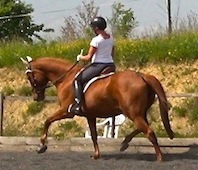 At HHT, our training work with horses has a strong gymnastic basis - we are interested in cultivating balanced movement so that we can enhance the horse's power, suppleness and relaxation. We have noticed that in order to connect with the horse and genuinely influence his way of moving on this physical level, it is essential that the horse's own awareness comes into his body, instead of being focused either on his external environment or too directly on the person who is working with him. This may seem paradoxical, because surely if a horse is to be receptive to the trainer's instruction, he must be focused on that person?
At HHT, our training work with horses has a strong gymnastic basis - we are interested in cultivating balanced movement so that we can enhance the horse's power, suppleness and relaxation. We have noticed that in order to connect with the horse and genuinely influence his way of moving on this physical level, it is essential that the horse's own awareness comes into his body, instead of being focused either on his external environment or too directly on the person who is working with him. This may seem paradoxical, because surely if a horse is to be receptive to the trainer's instruction, he must be focused on that person? This question was highlighted by a horse we took on for training recently, who was, to begin with, particularly difficult to 'get through to' in terms of influencing his way of going. In the preparatory work on the lunge, that we always start with before riding a horse, he moved hollow in his back and on the wrong bend, with, most importantly, a lot of tension and reactivity. This tension was mainly due to a history of bad handling and training, combined with physical issues. The way it manifested in his work was that his mental focus was entirely fixed on the 'outside', and, interestingly, very much on the person working with him. On the lunge he would often suddenly stop, turn in towards the center and fixate on the person lunging him, in an almost interrogatory fashion. Then, when ha was asked to go on, he would over-react with tension and excessive energy. Working with horses like this makes it clear to us how different their mental focus is to that of our own horses, who are used to working in a calm and receptive way. The difference is that their mental focus is not at all on their own bodies, but instead on everything outside of them. This external awareness was not at all conducive to this horse being able to change his way of moving and balancing,
Above: A horse with a similar outward awareness as the one described, and a similarly unbalanced way of moving [NB: this is not our training]. As well as sensing it intuitively, you can see where the horse's awareness is by looking at his expression. When he has inner focus, his ears are usually half-turned backwards instead of pricked forwards (although not 'pinned'), and his eye will look calm and introspective. Compare the expression of the horse above, and that of the chestnut at the top of the page. Inner focus becomes an obvious energetic state when you get used to recognizing it.
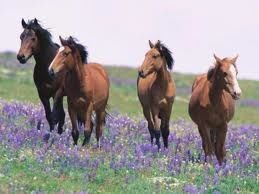 This comes down to horses being prey animals. Whenever they are in a situation where they do not feel completely safe, their external awareness becomes heightened. This is part of their defense response towards any possible threats in their environment. This is why, in order for a horse to have an inner focus on his body, he must be calm and confident in his surroundings. Domestic horses do not have the threat of predators, but if their lifestyle does not give them the security they get from stable social interaction, sufficient freedom and natural care, then the same tension will mount in them as in the prey animal under threat, resulting in a lack of ability to let the defenses down in a training situation.
This comes down to horses being prey animals. Whenever they are in a situation where they do not feel completely safe, their external awareness becomes heightened. This is part of their defense response towards any possible threats in their environment. This is why, in order for a horse to have an inner focus on his body, he must be calm and confident in his surroundings. Domestic horses do not have the threat of predators, but if their lifestyle does not give them the security they get from stable social interaction, sufficient freedom and natural care, then the same tension will mount in them as in the prey animal under threat, resulting in a lack of ability to let the defenses down in a training situation. With the horse described above, his lack of ability to put his focus on his body was, to a large extent, due to his high level of mental tension from a lack of trust in people, although it was obviously intensified by the fact that he was in new surroundings with us. There was also another factor that we believe added to this mindset: the fact that he had been kept entire until relatively recently, giving him more stallion-like tendencies. Because the stallion's role in the wild herd is to protect the mares from dangers such as predators, and also to guard them from other stallions, it is likely that they naturally have a more developed outward mental awareness than mares or geldings. This idea is backed up by other experiences we have had with entires or rigs, who also had difficulty bringing their mental focus inwards.
Another reason that a horse may not want to 'be in his body' is that he has physical discomfort that makes it unpleasant for him to really feel his body. Such horses often try to distract themselves by focusing on their outer environment. See Equine Back Problems. Training that brings the horse's attention back into the body often plays an important part in resolving the problems in these horses, because conscious awareness is an indispensable part of activating the body's intelligence to bring about healing. This is why, for example, synthetic painkillers, and other drugs that remove the symptoms of problems are never a genuine solution, because they only help to disconnect the mind from the real state of the body. When we are working with a horse - whether on the lunge, in hand, or under saddle - the way we help to bring his attention into his body is by focusing our own attention on it. There are two dimensions to how we do this. One is physical, with the aiding we give the horse, and the other is conscious, by connecting to the horse's physical/energetic state with our own mind. 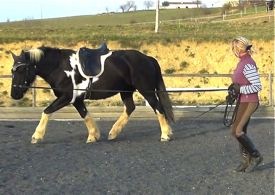 For example, if we are working with a horse on the lunge who is moving hollow, out of alignment, and has an outward mental focus, one major part of our work to bring him back into his body is to align him onto the bend with the help of the contact in the lunge line, and aiding from the lunge whip, which in turn encourages the longitudinal stretch (when the horse drops his head and raises his back). We also use this physical aiding to control his speed in a way that is conducive to postural engagement. (For more about lungeing technique see: How To Lunge A Horse Well and How To Train A Horse Without Force)
For example, if we are working with a horse on the lunge who is moving hollow, out of alignment, and has an outward mental focus, one major part of our work to bring him back into his body is to align him onto the bend with the help of the contact in the lunge line, and aiding from the lunge whip, which in turn encourages the longitudinal stretch (when the horse drops his head and raises his back). We also use this physical aiding to control his speed in a way that is conducive to postural engagement. (For more about lungeing technique see: How To Lunge A Horse Well and How To Train A Horse Without Force)
At the same time as this physical interaction, we must focus our conscious awareness on the state of the horse's body, in a kind of highly focused, meditative connection. In doing this, we are really trying to feel the horse's body as he moves along, especially noticing any blocks in the energy or flow of his movement, just maintaining our attention on such restrictions until they shift. When we become practiced at this, we will become aware of the great difference in the horse's balance and energetic flow when he is moving in alignment and engagement, and when he is not. This conscious awareness is a skill that can be developed with practice. It is a powerful tool in bringing the horse into his body, making him more receptive to the other 'physical' aids. Above all, what we do not want to do when a horse is focusing his attention externally, is to put our focus on his mind, to attempt to engage in any way with his thought processes and anticipatory reactions.
Putting one's awareness on the body is actually a very good way of becoming more present, and less stuck in an endless chain of time-based thoughts. 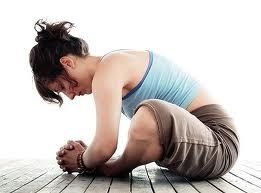 This is the kind of awareness that is developed in such meditative practices as yoga and most martial arts, and is often acquired by those practicing demanding and highly-focused sports and other physical activities. We believe this conscious state has the same benefit for horses as it does for humans. Even though horses may not think in the same intellectual way that we do, any fear-based state of mind, such as tension, anxiety, even dissociation, is by nature a resistance to being in the 'now', and horses are just as susceptible to these states as we are. We feel this is part of the reason that gymnastically sound work has such a calming and healing effect on horses: it is not just therapeutic for their body, but also for their mind and spirit.
This is the kind of awareness that is developed in such meditative practices as yoga and most martial arts, and is often acquired by those practicing demanding and highly-focused sports and other physical activities. We believe this conscious state has the same benefit for horses as it does for humans. Even though horses may not think in the same intellectual way that we do, any fear-based state of mind, such as tension, anxiety, even dissociation, is by nature a resistance to being in the 'now', and horses are just as susceptible to these states as we are. We feel this is part of the reason that gymnastically sound work has such a calming and healing effect on horses: it is not just therapeutic for their body, but also for their mind and spirit.
HHT's monthly Try This At Home Tip Developing Inner Focus Practice bringing your own awareness into your body as regularly as you can. This could be during activity or rest, but especially try it when you are stressed for any reason. Instead of letting thoughts fill your mind, try to just be aware of what your body feels like, whatever that may be, and stay with that feeling, whether it changes or stays the same. Your mind will probably drift back to thoughts again, which are more entertaining for it, but just practice bringing the focus back to your body, in a quiet, attentive way. Developing this ability in yourself will increase your capacity to focus on your horse's body, encouraging him to do the same. Then practice focusing your attention on your horse's body, first when working on the lunge, then when riding. Again, it requires a lot of mental discipline to keep your focus on pure physical states rather than your thoughts and mental processes (or interacting with those of your horse) but your ability will improve with practice. It may help to almost imagine you were the horse, and how his muscles would feel as he moves along, how the ground would feel as his feet push off it, and so on. The visual aspect of working with a horse on the lunge, and the fact that you are more physically distanced, make this a more simple context in which to practice this skill at first, but it can be just as powerful when riding, where you also have the physical interaction of your body with the horse's to focus on, at the same time as the more extended physical and energetic state of the horse.
Just Click here to go to the HHT group page, and then click on the 'join group' button at the top right of the page.
Sharing the Holistic Message
If you enjoy Happy Horse Training and you find the information on the site useful, please help us to share it by clicking on the Facebook 'like' and 'share' buttons (if you have a fb account) that are on each page. Any other way you can pass the site on to friends and colleagues via, for example, discussion forums, is of course also greatly appreciated. You can also sign up to our RSS feed (blog) to be kept up to date with new ideas, pages and other information that we post there. Just click on the box that says 'subscribe to this site' at the left of each page. The equestrian world is one dominated by traditionalist ideas and conventions, but we like to think we can help inform the growing minority of horse-owners who want to make their horses happier with progressive and holistic methods. Happy Horse Training now has over 100 pages exploring many different areas of holistic equitation. Do have a look through our site plan to find the subjects and categories that interest you.
Available from HHT: 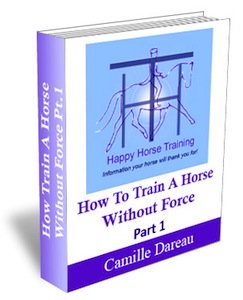 The first part in HHT's Training series: How To Train A Horse Without Force. This quality e-book gives you a unique holistic understanding of training horses, from the very first contact with a young horse, through to a thoroughly explained method of lunging that is beneficial for any horse, not just in preparation for first riding, but at any stage of training.
The first part in HHT's Training series: How To Train A Horse Without Force. This quality e-book gives you a unique holistic understanding of training horses, from the very first contact with a young horse, through to a thoroughly explained method of lunging that is beneficial for any horse, not just in preparation for first riding, but at any stage of training.
With your purchase you will receive a free bonus supplement on Horse Trauma - cutting edge insights on this subject that up until now have mostly been applied only to human trauma. This supplement shows how to recognise, avoid and deal with horse trauma, which is much more common that we realise. These two e-books, comprising more than 75 thousand words and richly illustrated, are available for only 19.99 Euros (around $26). Click here for more details.
|
| Back to Back Issues Page |
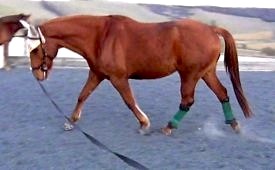
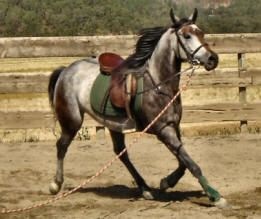 instead it completely blocked the tension into his body, and made him impervious to the aids he was being given. Until he was able to be in his body sufficiently with his awareness, we would not progress with his training.
instead it completely blocked the tension into his body, and made him impervious to the aids he was being given. Until he was able to be in his body sufficiently with his awareness, we would not progress with his training.
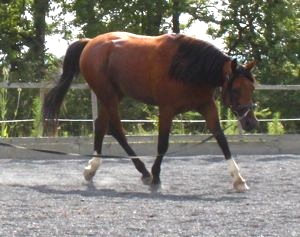
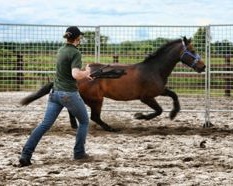 There are many training techniques, especially in natural horsemanship, that focus on interacting with the horse's mind through a system of signals, whether vocal or gestural, in order to influence his thought processes. This is a sure way to keep the horse's attention out of his body, and is therefore undesirable for any training that has a gymnastic basis, i.e. that is concerned with bringing the horse into balance and creating unity with the rider. The horse described above had also been trained some of these mind-focused techniques, and it was clear how utterly different his connection with the trainer was when he was expecting this type of interaction, compared to when he was putting his awareness calmly on his own body. The calm inner focus went along with him working in a balanced, stretched and aligned way, whereas in the other 'mental-training' mode he moved hurriedly and disjointedly, with sudden sporadic reactions, combined with a general misalignment and hollow postural.
There are many training techniques, especially in natural horsemanship, that focus on interacting with the horse's mind through a system of signals, whether vocal or gestural, in order to influence his thought processes. This is a sure way to keep the horse's attention out of his body, and is therefore undesirable for any training that has a gymnastic basis, i.e. that is concerned with bringing the horse into balance and creating unity with the rider. The horse described above had also been trained some of these mind-focused techniques, and it was clear how utterly different his connection with the trainer was when he was expecting this type of interaction, compared to when he was putting his awareness calmly on his own body. The calm inner focus went along with him working in a balanced, stretched and aligned way, whereas in the other 'mental-training' mode he moved hurriedly and disjointedly, with sudden sporadic reactions, combined with a general misalignment and hollow postural.